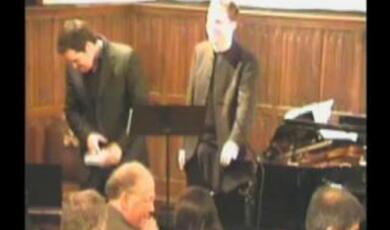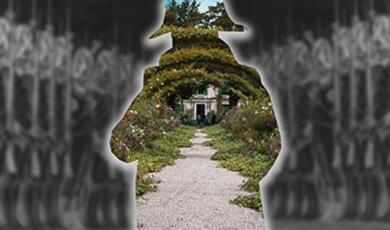The Songs of Summer
Share
- Details
- Text
- Audio
- Downloads
- Extra Reading
Throughout May and June the British Isles resonate to some of the strangest and most beautiful sounds on earth; the voices; rhythms and music of our wildlife. In an acoustic journey from the vast seabird cliffs in the far north to nocturnal soloists hidden in deep cover within Home Counties woodlands Chris Watson celebrates the sonic biodiversity found across our unique landscapes.
Download Text
Chris Watson
22/06/2010
This is the International Year of Biodiversity and that has inspired me. I like the idea of bringing recordings here that I have collected and recorded across the length and breadth of Britain over the last two years. Indeed, I made one of the recordings in response to something I heard on the news. Thus I have not chosen international biodiversity, but our national biodiversity. I have selected nine British habitats which reflect our astonishing national biodiversity and reflect strongly and powerfully the variety of sonic diversity across our islands. The recordings are all linked to summer so many of the songs are starting to come to a close as summer has reached its peak and the Summer Solstice has passed.
I will begin in the far North-West of the British Isles, and then move north to south because that is how daybreak reaches our country. The first daylight in June hits the British mainland around Caithness in Scotland and then travels in about hour and 10 minutes to Cornwall and the South-West. At the moment, summer official sunrise is about 5:00 to 5:15. In fact, the animals respond before the daylight, so part of what is being tracked is a sonic path in advance of the breaking daylight.
These first recordings are from some of our great sea-cliffs; we have some of the most astonishing sea-cliffs in Europe - St Kilda in the Outer Hebrides, Shetland, and Hoy on Orkney. These have a remarkable biodiversity and, not least, an incredible population of birds, and many of the animals are numbered in their tens and hundreds of thousands. For the first piece I shall illustrate the basic sounds of the sea cliffs. If one stands by the Outer Hebrides in January or February then the sea is heard, as is perhaps one sound from the resident population of gulls. This is the template upon which all the other birds mark their sounds as they arrive later in the year.
[Recording plays]
After January and February comes March when the first birds arrive. This bird is a true sea bird; it is the seagull, the kittiwake, which is onomatopoeic. These are beautiful white seagoing gulls with jet black wing tips. They arrive in March and as soon as they arrive, within a couple of days, the whole soundscape of these sea-cliffs changes radically because these are colonial nesting birds and very aggressive about finding the best nest positions. This is the sound of a group of kittiwakes on the same sea-cliffs.
[Recording plays]
The kittiwakes are joined very quickly by a group of lesser known, but very vocal, birds, a family of birds called auks. The best known species of that family is the Atlantic Puffin, which most people will know simply by the colourful portrayals of them in the media. The auks, like the kittiwakes, are highly social, so they build an incredible density of sound on our sea-cliffs. They are often named seabird cities. Often, some of the auks become seabird tenants because they live right next to each other, building their nests on the cliffs. Puffins, however, actually make burrows into the ground, and communicate with each other through this honeycomb network, with sounds that are about as comical as their appearance.
[Recording plays]
The puffins' cousins which live in their nests on the exposed rock faces are guillemots. These are very robust black and white auks, who build no nest and they cram together in their tens of thousands on narrow ledges. They lay very conical shaped eggs that roll around which they hope do not fall off the cliff. They are predated a lot by birds such as peregrine falcons and larger gulls, so one of the reasons they have evolved is the density of their population, which gives rise to this notion of seabird cities. They are highly vocal birds who appear to be complaining to their neighbours and calling their mates.
[Recording plays]
There is one more species in that family - the razorbill - which meshes into the soundscape. It is interesting how all the calls are different, and they all have a frequency, which seems to fit into place much like a jigsaw. These are much more solitary birds. They nest in crevices - holes in the rocks - so their single eggs and chicks are protected not so much by the presence of other individuals but by the habitat. They have this very beautiful sort of throaty, rasping call. They are nearly always heard in isolation, and the sounds are coloured by the reverberation of the rocks within which they nest.
[Recording plays]
These birds take several weeks, about a month, to arrive. If someone were to go and stand on a headland at St Kilda or on the Old Man of Hoy on Orkney this week, they would hear an initial cacophony. This would be an accumulation of all the sounds which build up on the great sea-cliffs, and these birds now defend a small nest site and feed the young as part of this frenzy of noise and activity.
[Recording plays]
The next place I have chosen is on the mainland, but sometimes just behind sea-cliffs, and these are our moorlands and mountainsides. These are characterised by having far fewer birds and birds that have no perch other than the ground. Most of these pieces feature birds, but there are some other vocal animals, or animals which have aerial displays - they sing from the sky or in flight. That is characterised by their behaviour, and so they have huge territories. They can travel a kilometre or so in the course of one of their song flights.
The first bird is very familiar; it is, to quote Shakespeare, the ploughman's clock. It is commonly known as the skylark; and it would be the first bird to start singing. This is the aerial song flight of the skylark.
[Recording plays]
I have been working on a BBC2 series called Spring Watch, covering skylarks in Dorset. Two weeks ago, I took a recording of a skylark and took a one second sample of it. I expanded it out, and counted 36 different notes. Some of the current scientific thinking about birds like the skylark is that they live in a different timeframe from humans. Their temporal resolution is far greater than that of humans. The current theory is that an adjacent skylark - unlike humans who just hear a beautiful blur of notes over one second - can resolve each individual note and gather from that the information required about the bird's sexual status, its breeding activity and its aggression. There are many things which I find fascinating about birds which we understand, but there is far more which we are yet to comprehend. This, for me, is part of the beauty and appeal of studying birds.
The next bird I wish to introduce has another onomatopoeic name - the curlew - which breeds in the far North and around Northumberland. Indeed, it is the symbol of the national park despite being a Scottish bird. This recording is of a curlew's song flight, but, unlike the kittiwake, this is the passage of a bird over several hundred metres.
[Recording plays]
Interestingly, there was a complete absence of any other birds at that time.
[Recording continues to play]
Of course, it is not always such a nice, calm, dry and clear morning. The moors which have not been overgrazed by sheep are characterised by heather, sage and rough grassland. Heather in particular has a really beautiful, solid detail when the microphone is close to the ground. It appears to sing, rather like coniferous needles, when the breeze catches it. This recording is a more realistic sound of Scottish heather moorland. Actually, this is grass moorland and the bird that is singing - a golden plover - is in aerial display, while the microphone is in the grass.
[Recording plays]
The first woodland I have chosen is from the remnants of the great wood of Callendar; the Caledonian pine forests of the North and East of Scotland, which used to have a massive and extensive range. It has been largely deforested but remains a forest that has been characterised not only by some very ancient trees such as Scots pines, but also by the fact that they have been there for hundreds of years. Some of the trees where these recordings were taken - dragon pines - are over 300 years old. People from Trees for Life were eloquently saying that some of these trees sheltered the dead and the dying after the Battle of Culloden in 1746 and were mature even then. One especially wonderful thing about this woodland, like no other forest in Britain, is its acoustics. The huge trees, with very little under-story, reflect and bounce sound around under the canopy. Therefore, even common birds, such as those in this next recording, have a particular, and sparkling, acoustic, which could emanate from no other British habitat. This bird is a mistle thrush, which is quite a large, powerful bird, sometimes known as the storm cock. It is singing from high up in the Scots pines, being accompanied by a grumpy sounding pigeon. However, it is the acoustic which is the crucial element - it is almost cathedral-like.
[Recording plays]
This next recording is one of my favourites. I made it a few years ago. The capull-choille is a bird whose Gaelic name means 'the horse of the woods'. It may become extinct again in our lifetimes in the islands of Scotland. It was shot to extinction and then re-introduced, and their habitat was, again, in the woodlands. However, it remains in serious decline. The RSPB and some of the forest estates are doing a lot to try and help this bird survive. It is the largest of our grouse, which has an astonishing display often described as champagne corks popping. These are sounds that were recorded within a metre of the bird, and I was on the end of a very long cable. However, many of these sounds would be inaudible at three or four metres away. This is a response to the extinction threat. These birds used to have great social displays but this recording is the sound of one capull-choille in Speyside, desperately trying to attract a female.
[Recording plays]
There are two dawn choruses in this piece, and this is the first one. This is a dawn chorus recorded in Glen Affric in the Highlands of Scotland, in a really beautiful remnant of the Caledonian pine forest there. Again, there are dozens of birds in this, some of which are endemic, like the Scottish crossbills but the interesting thing is that the frequency and content of this chorus mean that this could be no other location, even in Europe. It has this sparkling acoustic. The interesting thing about this track is not so much the individual component parts but the chorus of the whole. It has this golden wall of sound, which is still present towards the end of June.
[Recording plays]
It is a place, fortunately, which has yet to, unlike the rest of our country, suffer too much noise pollution from aircraft.
This next habitat is more of a general location. It is freshwater - there are freshwater streams, lakes and rivers in Britain. These are something recorded in North Wales last year, and fortunately, there are no birds in this piece. There are two animals whose sounds shall be played, from different mediums - a fish and a bat. However, they both hunt the same prey and that is what they are doing in this piece. This is a brown trout rising in the small stream off Lake Burnley.
[Recording plays]
That was probably the shortest recording I have yet it probably took me longest to make. Interestingly, the trout is rising for a Canadian mayfly that has recently hatched. Those fish eat hundreds of thousands of those insects as they unfortunately rest at night. I was down by a stream, just at sunset, with a device called the bat detector, which decodes the very high frequency of echo location calls of bats. These occur typically at frequencies well below our frequency of hearing; it decodes them and it drags them down into our audible frequency range. Humans view the river as a beautiful place to go for a walk with its calmness. Unbeknown to humans, at sunset, is the mayhem and chaos of the carnivores above our heads, the bats, who are hoovering up tens of thousands of insects. The recording begins with the peaceful river sound, and is then mixed with the devastation and carnage which is caused by the bats, and then comes back to the human frequency of hearing. These are sounds that will be happening outside tonight at about 10 o'clock. There will be lots of bats coming out of this beautiful building and some of the others, and eating up lots of the insects around. This sort of sound is always happening but is marginally out of our frequency of hearing.
[Recording plays]
These are Daubenton's bats, which are hawking insects above the surface of the water.
[Recording plays]
The rivers flow into the sea, but many of them wash around our offshore islands, which is the next habitat I have chosen, and these recordings are both from Welsh islands. The first one is on the Skerries, a very narrow lump of rock, but upon which nests a remarkable bird, which sees more daylight than any other animal on Earth. They nest a lot in our offshore islands. These are Arctic terns. Therefore, the birds on this track, which breed on the Skerries in the Faroe Islands and the far north will leave their nests by August and fly to the South Atlantic and Antarctica during winter, and then fly back next summer. Those which survive - the mortality rate is very high - will travel over 20,000 miles with their own power every year. They are highly vocal birds. We call them Arctic terns, but the best common name is the Icelandic onomatopoeic name of Kria.
[Recording plays]
The island I was recording on last year was the island of Barnsley, and this is a recording of the commonest bird on Barnsley, a bird which numbers maybe 20 thousand pairs called the Manx shearwater. The only ones seen during the day are dead ones lying on the path that did not return the previous evening. These, like the puffins, are burrow nesting birds. They will occupy, and sometimes evict rabbits from the burrows, lay their single eggs inside, and take it in turns to incubate, while the other partner feeds somewhere, such as near the Bay of Biscay. These are birds rather like swifts, which do not have legs. The feet are attached very low back on the body, so they cannot perch. They can only hit the ground and skid, and they need to take off from a ledge. They have to choose their nesting sites very carefully, because they get one chance to come in at night, and they have to run the barrier of marauding gulls in Wales and further up the coast, so there are a lot of fatalities. Due to this, which is the way they have evolved, they tend to come in at night, when it is cloudy or foggy, so they can avoid these predators and hit their target. This sound is not heard at all in daylight. There is a 12th Century monastery nearby. I was wondering what the monks must have thought inside their cells at night, when these spirits and demons descended on dark, foggy, cloudy nights. Rather like the bats, the first track I have recorded for a few seconds is the Nats Valley in Barnsley, just before sunset, which, again, is quite a sea-sound filled valley. However, it was very quickly dominated by the return of thousands and thousands of Manx shearwaters.
[Recording plays]
Britain is of course an island, and one of the great sounds of summer is one that we are rarely privileged to hear. That is the sound of the sea from underwater around our island, and recently, I have been making a lot of recordings with underwater microphones. I have made lots of recordings of this animal, which I am going to play, so much so that I reckon this is the commonest wildlife sound in Britain. It is just that it is underwater and therefore people rarely get the chance to hear it. It is a very tiny animal. This is the snapping shrimp or the pistol shrimp, which is accompanied by an astonishing range of statistics. It has asymmetric claws, so even though it is only 2cm long, it has a very large lobster-like claw, which it uses to close at an alarming speed. It closes its jaws so quickly, it creates a vacuum underwater, and as the water collapses into the vacuum, it makes this very, very loud sound - 218 decibels, which is louder than a 747 at takeoff. The sound stuns its prey which is tiny fish, shrimps, and plankton, which it then seizes. The density of them in Britain's shallow waters is such that I am sure it is probably the commonest species. This is not very musical but nevertheless I think it is the commonest wildlife sound on this island.
[Recording plays]
One place where most people spend a lot of time, whether on their own or with somebody else, is the garden or the park. Gardens are a crucial part of the British habitat, not least because of the pleasure people get from them, but also because of the biodiversity that they support, including what used to be very common species. Places like gardens, and to some extent parks, have become havens for them. The common frog for example - many farm ponds have gone that people who take the trouble to have a pond in the garden can very quickly support an important population of these amphibians. I was playing that last recording to somebody the other day - they walked in when I was playing it. It was one of my kids, and he said, 'Oh, is that a recording of rain?' which gave me the inspiration for this piece, because one of the sounds of an English summer is the sound of rain. This is a recording made in my suburban back garden in Newcastle, so it is the sound of rain. Actually, it is the sound of this very unusual duet of common frogs, which were still singing actually in late May, in what remains of our garden pond, and the blackbird, one of our commonest thrushes, which is one of the most beautiful songbirds in the world. However, it is often overlooked. Again, there has probably been a resident bird singing in the courtyard today, a bird that people tend to disregard because it is heard so often, but when one takes the time to record it, or just stand and listen to it, it has this astonishing depth and beauty. Here, it is accompanied, unusually, by a frog, and some rain on the foliage?
[Recording plays]
There is one other song of summer which I was reminded about yesterday, and this recording is just over 24 hours old. I heard on the radio about the demise and decline of bees, in Britain and across Europe. They have suffered again from changes in farming practices. I think there is going to be investigations as to what has happened to them. Therefore, I went outside, and actually, to cut our hedge and was relieved to hear it was full of bees, which enabled me not only to say that I could not cut the hedge, but also to plant two tiny personal microphones inside this very small hedge in our front garden. These recorded, very simply, one of the most familiar and beautiful songs of our summer and it is necessary to ensure we protect bees to protect this song.
[Recording plays]
My penultimate habitat is heathland, because it was new to me. I have the privilege of working and travelling abroad a lot, but there are parts of England which I have yet to spend much time recording in, and one of them was Dorset and our heathlands. In fact, I was there over the last few weeks, working on a production. I am amazed at how Mediterranean that landscape is - coniferous trees, gorse and heather, very dry, full of amphibians, snakes and lizards, a really interesting biodiversity, but with very few birds. Some birds which are very typical of that habitat are very localised, such as the Dartford warbler. It is a bird of the night which really caught my attention because it is the bird that advertises its presence by sound. This recording is of a European nightjar, which is a very cryptic, superbly camouflaged bird. I have yet to see or find anybody who has ever found or even seen the nest of the nightjar. They sing at night, a long froglike song, where they perch in parallel with the branches of trees, rather than crossing them, as most birds do, and they gather - they are fairly social birds and they gather in the evening. They are very corpuscular birds and their main song periods are around sunset and just before sunrise. Therefore, this is a chorus of nightjars on the RSPB reserve in Arne in Dorset, recorded about two weeks ago at about eight o'clock at night.
[Recording plays]
I have one more track and I had to choose deciduous woodlands. This is because it must be one of the nation's favourite habitats, and also because I have been working on a programme for Radio 4 about searching for a song of a nightingale which is on the 5th of August. I spent a lot of time in late May, around places like Rutland Water, trying to find these birds and record them, but also to record our dawn chorus. I think, in Britain's latitudes, and having heard lots of tropical dawn choruses and choruses around the world, without doubt, Britain has the best dawn chorus on the planet. Being 50-odd degrees north, unlike the Tropics, the sun takes quite some time to rise and set. Most of the birdsong is in advance of the sunrise. Therefore for a dawn chorus walk it is best to go early. These recordings were made about 3am, and the best songs in the dawn chorus were about 4am, in May, when it was still dark. Nevertheless, it demonstrates this astonishing diversity, power and volume of birds. I have morphed three tracks together, so this covers the passage of time from about 3am until about 5.30am, so it starts with a nocturnal solo, one nightingale singing in deep cover. I never saw this bird, and I must have been only three or four metres away from it. It was incredibly loud and powerful and was not at all daunted by my presence creeping around with a microphone. It was then joined by another bird, because that part of the reserve in Rutland has a good density of nightingales. This really is a bird of the South and East. This was, interestingly, a song battle, so songs that we associate with being this beautiful lyrical song are in fact powerful, aggressive male territorial battles for the best females, requiring the most powerful sexual status and the best habitat, so there is a real powerful message in these songs. Eventually, they were drowned out by one of the densest dawn choruses I have heard. Unlike coniferous forests, there is a lot of understory and a lot of hawthorn shrub where smaller birds - dunnocks, wrens and whitethroat - also sing.
[Recording plays]
©Chris Watson, Gresham College
Part of:
This event was on Tue, 22 Jun 2010
Support Gresham
Gresham College has offered an outstanding education to the public free of charge for over 400 years. Today, Gresham College plays an important role in fostering a love of learning and a greater understanding of ourselves and the world around us. Your donation will help to widen our reach and to broaden our audience, allowing more people to benefit from a high-quality education from some of the brightest minds.


 Login
Login






